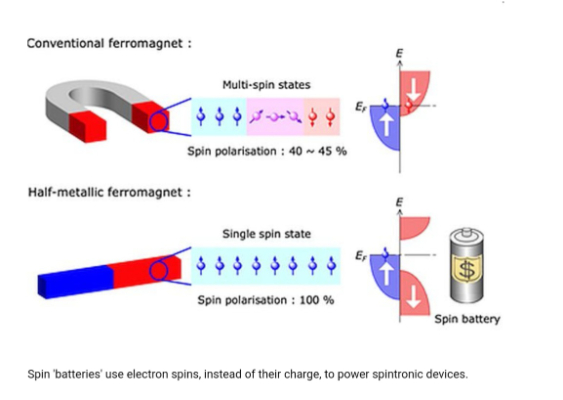Putting A Spin On Heusler Alloys
A review on the latest research of the various types of Heusler alloys summarizes the field's main achievements up to 2020.
Tsukuba, Japan, Mar 30, 2021 - (ACN Newswire) - A study published in the journal Science and Technology of Advanced Materials summarizes the major achievements made to-date in Heusler alloy research. "Our review article can serve as an ideal reference for researchers in magnetic materials," says Atsufumi Hirohata of the University of York, UK, who specializes in spintronics.

Spintronics, also known as spin electronics, is a field of applied physics that studies the use of electron spins, instead of their charge, to carry information in solid-state devices, with reduction in power consumption and improvements in memory and processing capabilities.
A category of materials showing great promise in this area is Heusler alloys: materials formed of one or two parts metal X, one part metal Y, and one part metal Z, each coming from a distinct part of the periodic table of elements. The interesting thing about these alloys is that individually, the metals are not magnetic, but when combined, they become magnetic.
A major advantage of Heusler alloys for spintronic devices is the ability to control their unique electrical and magnetic properties, which result directly from electron spins, by making changes to their crystalline structures. But this requires very high temperatures, which researchers want to reduce.
Over the last few decades, scientists have been working on approaches to grow Heusler alloy films at room temperature on special substrates with crystal lattices that are similar to the alloy's. The interaction between the two lattices can lead to the development of half-metallicity in the Heusler alloy, where only electrons spinning in one orientation are conducted through the material whereas those spinning in another are not.
Researchers need to be able to measure the properties of materials in order to conduct their investigations. The atomic structure of Heusler alloys can be directly observed by X-ray diffraction and indirectly measured through examining the relationship between the material's resistance to an electric current and temperature changes. Other techniques are also available for measuring their magnetic properties.
Hirohata and his colleagues are currently working on fabricating a metallic magnetic junction made of Heusler alloy films. These junctions are made from two ferromagnets separated by a thin insulator. When the insulating layer is thin enough, electrons are able to tunnel from one ferromagnet to the other. There is low resistance to electron movement as long as an external magnetic field is applied, but as soon as it is removed, the material becomes highly resistant to electron movement. "These devices are expected to replace currently used memory cells and magnetic sensors," says Hirohata. The team hopes to develop metallic magnetic junctions with much larger magnetoresistance than the current record at room temperature, realising a next-generation memory for a sustainable society.
Research paper: https://www.tandfonline.com/doi/full/10.1080/14686996.2020.1812364
About Science and Technology of Advanced Materials Journal
Open access journal STAM publishes outstanding research articles across all aspects of materials science, including functional and structural materials, theoretical analyses, and properties of materials.


 Richard D. Wolff, IMI: Political Economy Contradictions As We Lurch Into 2025
Richard D. Wolff, IMI: Political Economy Contradictions As We Lurch Into 2025 People with Disability Australia - PWDA: CMHA And PWDA Demand Justice And Urgent Reform Following Death Of Simon Cartwright At Silverwater Jail
People with Disability Australia - PWDA: CMHA And PWDA Demand Justice And Urgent Reform Following Death Of Simon Cartwright At Silverwater Jail UNICEF Aotearoa NZ: Vanuatu Quake - UNICEF Aotearoa Launches Urgent Fundraising Appeal For 40,000 Children In Need
UNICEF Aotearoa NZ: Vanuatu Quake - UNICEF Aotearoa Launches Urgent Fundraising Appeal For 40,000 Children In Need New Zealand Defence Force: Surveillance, Aid, Responders And Evacuees Covered By RNZAF Vanuatu Flights
New Zealand Defence Force: Surveillance, Aid, Responders And Evacuees Covered By RNZAF Vanuatu Flights Leonard C. Goodman, IMI: The Democratic Party Faces Its Day Of Reckoning
Leonard C. Goodman, IMI: The Democratic Party Faces Its Day Of Reckoning APEC: Korea Sets Ambitious Priorities For APEC 2025 - Building A Sustainable Tomorrow
APEC: Korea Sets Ambitious Priorities For APEC 2025 - Building A Sustainable Tomorrow